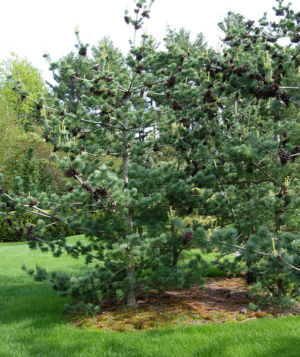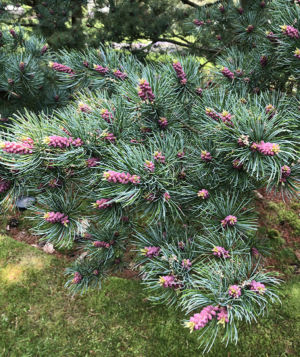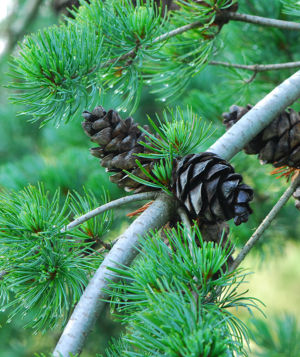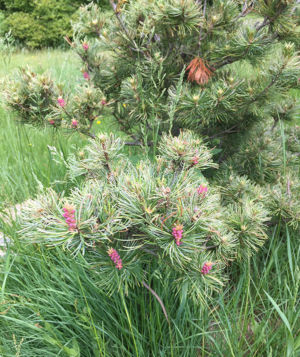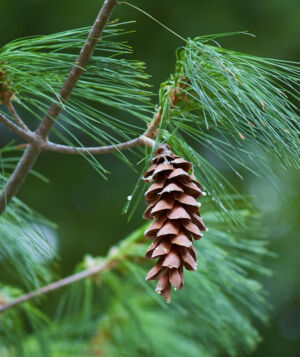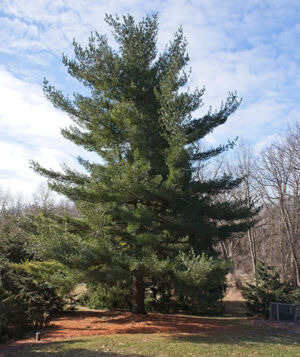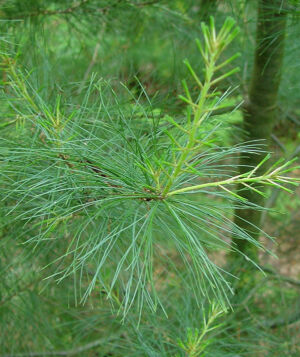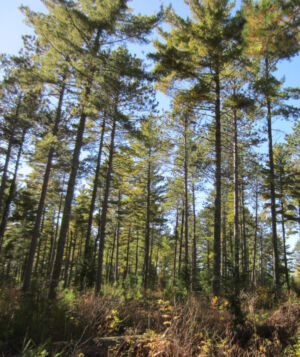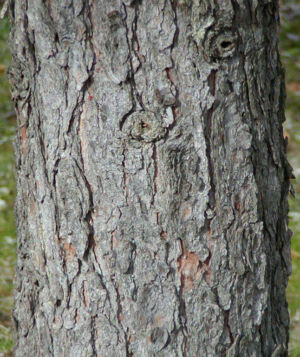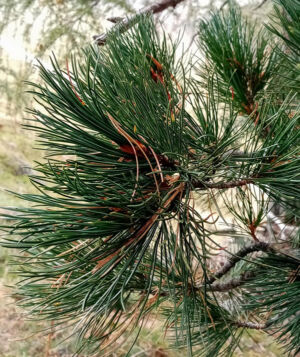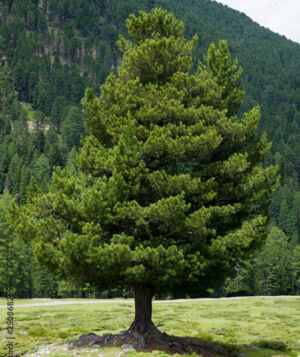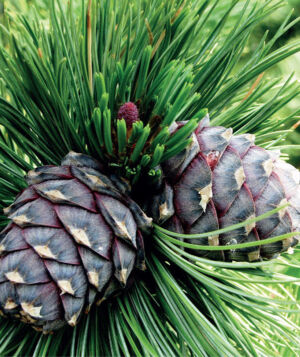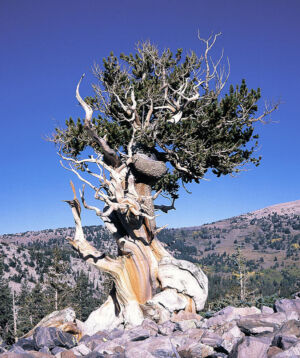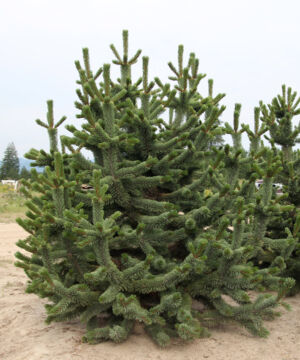Japanese White Pine – Pinus parviflora ‘Glauca’
Description
General: Native to Japan, Pinus parviflora is a slow growing evergreen that develops in a conical manner, with wide spreading branches. It will slowly grow to 25-50′ tall with age.
Leaves: Needles 1/2 – 3/4″ long by 1/16- 1/12″ wide tightly arranged along stem. Silvery grey in spring turning to a deep green with glaucous blue backing when mature. Two whitish stomatal bands divided by a thin green midrib line the underside. Notched or rounded at apex.
Cones: 1-4 cones can remain on trees for 6-7 years until opening up when ripe. Will produce many cones even in juvenile stages, which can weigh the branches down.
Bark: Smooth gray bark for most of its life. Begins to get platy in older age.
Attributes: Slow growing upright tree that can be planted in small quarters and can be easily controlled to not outgrow it’s setting. Has a beautiful bluish-green color and can make a prefect character or accent plant if pruned in an artistic manner. Also a good tree for coastal locations due to its salt tolerance.
Culture
Hardiness: Zones 4-7
Growing Conditions: Prefers full sun, good drainage and is reported to be salt tolerant.
Maintenance: Low maintenance except to prune to desired shape.
Transplanting: May be moved all season, avoid when new growth is occurring.
Our Experience
Experience at Great Hill
We have had wonderful success with the ‘Glauca’ cultivar. We have been growing ‘Gimborn’s Ideal’ and ‘Tanima no uki’, subsequently we can see how these selections grow compared with the ‘Glauca’ cultivar. We have also had some success grafting cuttings from the ‘Glauca’ cultivar.
Historical Winter Data
Winter 2016-17: No issues with the drought of the past summer at this time.
Winter 2017-18: Only issue we had was one tree heaved in a heavy wet snow storm in March. The soil it is growing in is a heavy clay, therefore a lack of strong root system and saturated soils may have played a role in the tree failure.
Eastern White Pine – Pinus strobus
Description
General: Pinus strobus is a fast growing, native, pyramidal pine with wide spreading branches. Grows 50-80′ tall in the landscape and up to 150′ in the wild.
Leaves: 2-4″ blueish-green, soft, pliable and slender needles in groups of 5.
Cones: 3-7″ long cylindrical, pendent and light brown. Mature in the fall of the second year.
Bark: Smooth gray bark becoming furrowed, dark and scaly with age.
Attributes: Fast growing, long lived native tree thats useful in parks, on estates and large properties. Can also be planted in a large hedge
Culture
Hardiness: Zones 3-7
Growing Conditions: Prefers moist, fertile, well drained soils with full sun, but is tolerant of dry, rocky, semi shaded sites. Not tolerant of salt or air pollutants. Susceptible to wind damage, rust and pine weevil.
Maintenance: Low maintenance except to prune to desired shape.
Transplanting: May be moved all season, avoid when new growth is occurring.
Our Experience
Experience at Great Hill
We are surrounded by several stands of old, stately eastern white pine. They are large, handsome specimens that add an impressive aesthetic to the surrounding wood line. Our biggest challenges with these trees are loss due to pollution (salt) and wind storms. They seed readily, however, our woods are full of seedlings.
Swiss Stone Pine – Pinus cembra
Description
General: Pinus cembra is a slow growing pine native to the mountainous areas of central Europe. While narrow and pyramidal in youth, it becomes open and flat topped with spreading, drooping branches when mature. Grows to 40′ in height (100′ where native) with a spread up to 25′
Leaves: Stiff, densely set needles in groups of 5. Dark green to blue green needles have white stripes and grow to 3″ long.
Cones: Short stalked and oblong, up to 2 1/2″ long. Green-purple maturing to purple-brown. Cones do not open, but fall on the third year and seeds are released by birds or through decomposition.
Bark: Gray/brown ridged, furrowed and scaly when mature.
Attributes: Used as a specimen tree for smaller landscapes or for mass plantings.
Culture
Hardiness: Zones 3-7
Growing Conditions: Prefers a well drained, slightly acid soil and full sun with lots of air circulation.
Maintenance: Susceptible to a number of pine ailments such as blights, rots, cankers, borers, beetles, miners and sawfly. Some resistance to blister rust.
Transplanting: Transplants easier than most other pines provided that cultural needs are met.
Our Experience
Experience at Great Hill
We have pinus cembra planted in a mass grouping to conceal a small utility building and a road on Great Hill. They provide form and function in this respect.
Bristlecone Pine – Pinus aristata
Description
General: A shrubby, incredibly slow growing pine native to high elevations in the mountains of Colorado, New Mexico and Nevada. Grows 8 to 20′ with an irregular spread. Known for being one of the oldest species on earth with several documented around 5,000 years old.
Leaves: Dark blue- green needles in groups of 5 are about 1″ long and can persist up to 17 years. Dotted with white resin.
Cones: Brown and cylindrical 2 to 4″ long. Contain a blunt bristle like prickle at the edge of each pine scale
Bark: Gray-green and smooth in young trees. Rust colored with age.
Attributes: Can be used in a rock garden setting, as a foundation or specimen plant as well as a bonsai.
Culture
Hardiness: Zones 4-7
Growing Conditions: Prefers poor, dry, rocky soils in full sun.
Maintenance: Susceptible to a number of pine ailments such as blights, rots, rust, cankers, aphids, borers, beetles, scales, miners and sawfly.
Transplanting: May be moved all season, avoid when new growth is occurring.
Our Experience
Experience at Great Hill
We feature a single bristlecone pine in a large shrub border on Great Hill. Its dwarf form and interesting growth habit add a unique aesthetic to the space it inhabits. While striking, our specimen has been in poor health over the last few years and is regularly treated for a needle blight fungus.

